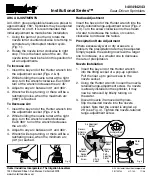
132
•
Fieldbus Communication
ETHERNET
WAGO-I/O-SYSTEM
750
ETHERNET TCP/IP
4.1.3 Network Communication
Fieldbus communication between master application and (programmable)
fieldbus coupler or controller usually takes place using an implemented
fieldbus specific application protocol, e. g. MODBUS TCP (UDP),
EtherNet/IP, BACnet, KNXNET/IP, PROFINET, Powerlink, Sercos III or
others.
The protocol layer model helps with an example (MODBUS and EtherNet/IP)
to explain the classification and interrelationships between the communication
and application protocols.
In this example, the fieldbus communication can take place using either the
MODBUS protocol or EtherNet/IP.
4.1.3.1 Protocol layer model
(1) Ethernet:
The Ethernet hardware forms the basis for the physical exchange of data. The
exchanged data signals and the bus access procedure CSMA/CD are defined
in a standard.
(1)
Ethernet
(physical interface, CSMA/CD)
(2) IP:
For the communication the Internet Protocol (IP) is positioned above the
Ethernet hardware. This bundles the data to be transmitted in packets along
with sender and receiver address and passes these packets down to the
Ethernet layer for physical transmission. At the receiver end, IP accepts the
packets from the Ethernet layer and unpacks them.
(2)
IP
(1)
Ethernet
(physical interface, CSMA/CD)
(3) TCP, UDP:
a)
TCP: (Transmission Control Protocol)
The TCP protocol, which is positioned above the IP layer, monitors
the transport of the data packets, sorts their sequence and sends
repeat requests for missing packets. TCP is a connection-oriented
transport protocol.
The TCP and IP protocol layers are also jointly described as the
TCP/IP protocol stack or TCP/IP stack.
b)
UDP: (User Datagram Protocol)
The UDP layer is also a transport protocol like TCP, and is
arranged above the IP layer. In contrast to the TCP protocol, UDP
is not connection oriented. That means there are no monitoring
mechanisms for data exchange between sender and receiver.
















































